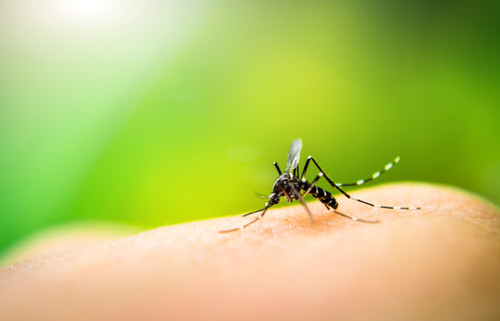Everything You Need to Know About Summer Skin Protection
With summer in full swing, many of your employees may be working outside, exposing them to sunlight, bug bites, and poisonous plants that can damage the skin and even leading to cancer or serious illness. To protect your employees from these potential hazards, make sure you provide sunscreen, bug repellent, and the proper skin protection equipment, such as long-sleeved clothing, protective eyewear, and other safety items.
Learn more about summer skin protection, so you can keep your employees safe in the sun.
Sunscreen
The sun emits two forms of ultraviolet rays, UVA and UVB rays. The former mainly accelerates the aging process, contributing to wrinkles, fine lines, and age spots. The latter can cause sunburn. UVB rays can also pass through glass, so you need to protect your employees even if they’re working indoors. Both types of rays are considered carcinogens, which means they cause cancer.
To protect your employees, you’ll need to keep plenty of sunscreen on hand. Sunscreen protects the skin from the sun’s ultraviolet rays. The American Academy of Dermatology recommends using broad spectrum, waterproof sunscreen, SPF 30 or higher, which blocks 96% of the sun’s rays. Evenly apply an ounce of sunscreen to all exposed areas of the skin every two hours. And replace your sunscreen once it’s past the expiration date.
Use both bottles of sunscreen and sunscreen pouches to keep it readily available to your employees. You can easily hand out pouches of sunscreen to your employees in the field if they need to reapply in the middle of their shift. Use sunscreen lip balm to prevent sunburn on the lips.
You can also have your employees wear long-sleeve shirts, pants, brimmed hats, and other protective clothing to limit their exposure to direct sunlight. Buy cool clothing and use cooling towels to keep your employees comfortable. And when possible, have them work in the shade.
Bug Repellent
Bug bites are another hazard you need to contend with if your employees are working outdoors. Insects such as mosquitoes, ticks, fleas, and certain flies can spread serious illnesses and viruses, such as dengue, Zika, and Lyme. Some of these diseases cannot be cured by medicine, so it’s vital that you reduce the chances of your employees getting bitten. Many of these insects tend to live in tall grass, open fields, and the woods.
Again, having your employees wear long-sleeve clothes and pants limits the amount of exposed skin. But some bugs can actually bite through thin fabric, so make sure the clothing is designed for bug protection.
You should also provide insect repellent to your employees, including spray and wipes, to keep these insects away from your employees. According to the EPA, all insect repellent should contain one of the following active ingredients: DEET, picaridin, IR3535, oil of lemon eucalyptus (OLE), para-menthane-diol (PMD), or 2-undecanone.
Reapply according to the instructions. If you’re using sunscreen as well, apply it before the insect repellent, otherwise, it may be ineffective.
Poisonous Plant Protection
You also need to protect your employees from poisonous plants, such as poison ivy, poison oak, and poison sumac. Direct skin contact with these plants can lead to a serious rash.
Poison ivy is known for its three-leaf structure with a red stem. It tends to grow low to the ground and may change colors throughout the year. Some plants may even develop green or off-white berries in the fall.
Poison oak is known for having three small leaflets, usually ranging from yellow to light green. The leaves are more lobed compared to poison ivy, although the two plants often get mistaken for one another. It can also grow yellow or white berries.
Poison sumac has seven to 13 leaves paired in rows with one leaf on the end and a red stem. Some plants have brown or black spots.
To protect your employees from all three of these plants, make sure they wear protective clothing that covers exposed areas of the skin, especially around the ankles, including long socks and pants.
If your employees work in areas with these poisonous plants, use Coretex Ivy X Pre-Contact Skin Solution before coming into contact with these plants to prevent a rash breakout. If contact does occur does occur, use Coretex IvyX Cleanser Towelettes to remove urushiol oils found in these poisonous plants.
Please also note that these same oils may be transferred on to clothing, tools and other objects. So removing clothing afterwards for a thorough washing is good practice, as is being mindful of which tools may be contaminated. These can be washed down to limit the spread of these extreme irritants.
Working outdoors in the summer comes with all kinds of potential hazards. Use these tips to protect your employees from the sun, bug bites, and poisonous plants. Contact the professionals at PK Safety for all your summer protection equipment needs.
Recent Posts
-
Customizing Gas Detectors: Tailoring Solutions to Fit Your Unique Requirements
In today’s diverse industrial landscape, a one-size-fits-all approach to safety simply doesn’t cu …Jul 3rd 2024 -
10 Ways to Prevent Wildfires
You can prevent wildfires by extinguishing flames before you leave the worksite. Avoid practicing …Jul 1st 2024 -
ANSI/ISEA 138 Safety Gloves: Ensuring Hand Protection
The human hand is an anatomical masterpiece and arguably the greatest tool attached to our bodies …Jun 25th 2024





